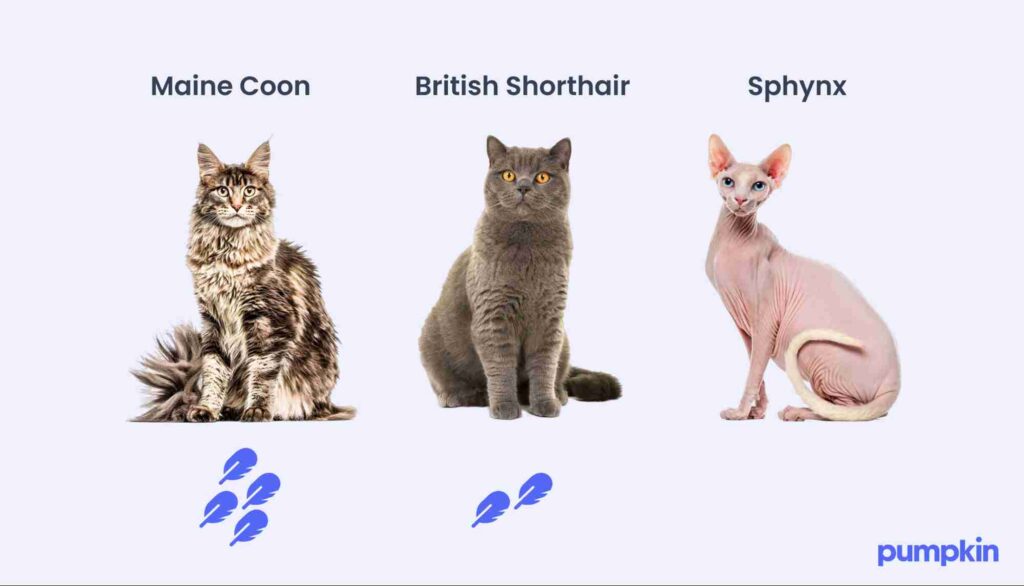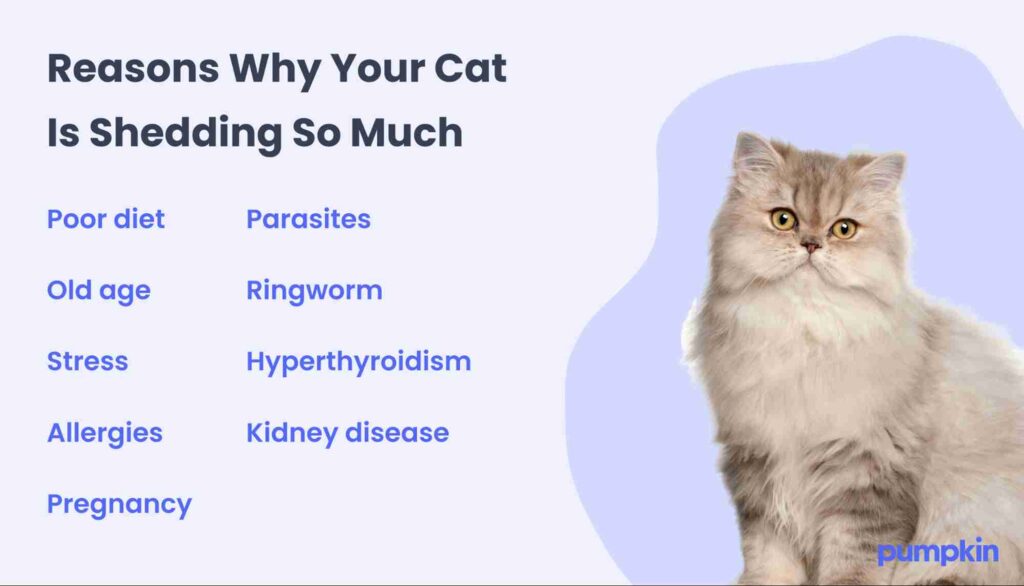- Randa Kriss
- Jan 21
- 6 min read
Key Points
What’s considered a “normal” amount of shedding varies for each cat based on factors such as breed, lifestyle, and time of year.
Common causes of excessive shedding include a poor diet, age, stress, allergies, pregnancy, parasites, ringworm, and metabolic disease.
A balanced, high-quality diet can help manage excessive shedding and maintain a healthy coat.
Every cat owner knows that no outfit is truly complete without a little bit of cat hair. Still, even the most cat-obsessed among us have our limits. If your lint rollers are working overtime, you might wonder if it’s just cat-shedding season or if there’s something more going on with your whiskered friend.
So, why is your cat shedding so much? And when should you be concerned? Let’s dive into some possible reasons behind excessive shedding in cats, with insight from a veterinarian. You’ll also learn cat grooming tips and common treatments.
How much do cats normally shed?
All cats shed to remove dead hair and replace it with new ones. This cycle also spreads natural oils that boost your kitty's coat and skin health; however, the ‘normal’ amount is unique to each cat. Factors like lifestyle, breed, and the time of year all influence how much fur you’ll find floating around.
For example, indoor cats tend to lose hair all year round whereas outdoor cats experience excessive shedding cycles based on the season. These cycles usually happen once or twice a year, mainly in the spring or fall.
A cat’s breed also plays a part in determining what normal shedding looks like. Long-haired breeds like Maine Coons and Persians shed way more than hypoallergenic cat breeds, like the Sphinx or Cornish Rex.
Then there are short-haired breeds, like the Scottish Fold or American Shorthair, who fall somewhere in-between when it comes to shedding.
Ultimately, you know your cat best, and if they suddenly start dropping hair all over your home, it should be obvious.

Common causes of excessive or increased shedding
So, why does your cat shed so much? In most cases, excessive shedding isn’t a major concern and is just part of the natural process of maintaining a cat’s healthy skin and coat.
But as your feline friend’s number one fan, trust your instincts. If their shedding patterns seem off or if they’re losing more hair than usual, it’s time to look into possible causes. Pay attention to signs like overgrooming, thinning coats, bald spots, or skin redness. These can all indicate that your cat may be experiencing more than the usual amount of shedding.
Let’s explore some common causes of excess shedding, hair loss, and skin problems in kitties:
Poor diet
A poor diet could be one reason why your cat is shedding so much. A diet lacking in protein and fats can’t support healthy skin and fur in your kitty, leading to thinning and hair loss.
Feed your cat a balanced diet that contains high-quality protein, carbohydrates, fats, minerals, and vitamins. Also, tailor your cat’s food to support their age and any health issues they're facing.
Age
Senior cats might struggle to keep up with their grooming routine as they age. The result? More fur flying around, messy hairdos, dandruff, and maybe even hard-to-pass hairballs. Plus, if your cat has arthritis, reaching certain areas to tidy up becomes even more challenging, making skin problems even worse.
If you think this is the case for your kitty, be sure to keep up with regular brushing to remove those loose hair and prevent tangles. And whether they like it or not, an occasional bath may be in order.
Stress
When your feline friend feels particularly on edge, they may shed more than usual. Sometimes, stress also causes cats to become obsessive lickers, leading to bald patches or irritated skin.
Watch out for changes in their body language or other cat behavior problems like increased meowing, avoiding the litter box, or changes in appetite. These signs might indicate heightened stress. To help ease their anxiety, try offering them extra mental stimulation and exercise.

Allergies
Cats can be allergic to certain foods, bugs, pollen, and even some common household products. This leads them to scratch more often, resulting in excessive hair loss. If the scratching intensifies, your cat may even develop red, irritated patches or bald spots.
Pro Tip: Any responsible pet owner should seriously consider pet insurance. Properly understanding how cat insurance works and what cat insurance covers can help you make an informed decision about your pet’s health needs and plan your finances accordingly!
The good news is you can help prevent this. If your cat suffers from a food allergy, your veterinarian can help you identify the culprit and remove it from their diet. This may involve running a food elimination trial with a hypoallergenic or limited-ingredient cat food.
Medication, supplements, or allergy testing may be necessary for serious environmental allergies. So if you suspect this is the case — don’t hesitate to see your vet.
Pregnancy
Pregnant cats experience hormonal changes, which can lead to an increase in shedding. Typically, these cats shed more hair around their bellies so their kittens can nurse easily. Generally, once lactation ends, mother cats resume their normal shedding patterns.
Parasites
Did you know that even shorthaired cats can fall victim to pesky parasites like fleas, lice, and mites? These parasites can wreak havoc on your kitty’s skin, causing excess shedding, bald spots, red bumps, and scabs.
If you suspect your cat has picked up any parasites, you need to bring them to your vet ASAP. Your veterinarian can recommend effective treatment options and tell you how to prevent future infestations.
Ringworm
This fungal infection spreads through contact with an infected animal or contaminated objects like brushes and bedding. Unfortunately, it's common in stray cats, who may have bald patches because of this infection.
If your cat has ringworm, you might notice round, scaly patches of skin with hair loss. Bring your cat to your veterinarian to know for sure. If a case is confirmed, they may prescribe topical creams and oral anti-fungal medication. In some cases, your vet might recommend shaving the affected areas so the medication can penetrate the skin effectively.
Metabolic diseases
Ever wonder why your cat’s coat isn’t as sleek and shiny as it used to be? Well, metabolic diseases like hyperthyroidism and kidney disease could be the reason.
Hyperthyroidism occurs when a cat’s thyroid gland becomes overactive, producing excessive thyroid hormone. Kidney disease, on the other hand, is when a cat’s kidneys function inadequately.
Both diseases can cause hair loss, matted fur, or a greasy and unkempt coat. Autoimmune disorders like lupus can also contribute to dandruff and excessive shedding in cats.
Luckily, you can manage these cat diseases with the right treatment plan. Although there’s no cure, catching these health problems early and starting treatment can help your kitty stay in tip-top shape.
How to reduce shedding and keep your cat’s coat healthy
While you can’t completely avoid it, there are home remedies for excessive cat shedding that you can try:
Apply recommended flea, tick, and parasite prevention like flea collars
Brush your cat regularly to help remove excess dead fur and hair
Help your senior, overweight, or long-haired cat with regular trips to the pet groomer
Vacuum or sweep up your cat’s excess hair frequently to prevent allergens
Take your cat to the vet for yearly or bi-annual check-ups to prevent health issues before they develop
Feed your cat a balanced, high-quality diet for reduced shedding and a shiny, healthy coat
When in doubt, don’t hesitate to call your veterinarian.
What else can you do to support your kitty as they grow up? Having a pet insurance plan in place can help you afford the best care when unexpected vet bills crop up. Learn more about how Pumpkin Cat Insurance plans can help cover costs related to future accidents and illnesses.
FAQs
What months do cats shed the most?
Seasonal shedding is normal in cats, and they tend to shed the most during spring and fall as they transition between their summer and winter coats. However, for indoor cats, shedding season may happen more evenly throughout the year due to artificial lighting and climate control.
Why does my cat shed so much when I pet her?
If you notice a lot of shedding when petting your cat, it may be time to grab the cat brush. Petting can help dislodge shedding hair as a form of grooming. While shedding is totally normal, you can minimize the amount of fur that comes off while petting with a regular brushing routine for your kitty. Remember: some breeds may require daily brushing.
How can I tell if my cat is stressed?
To determine whether or not your cat is stressed, watch for excessive grooming and appetite changes. Litterbox avoidance, aggression, or excessive vocalization are also signs of stress. If you notice these behaviors, address potential stressors and consult your vet for help.
REFERENCES

